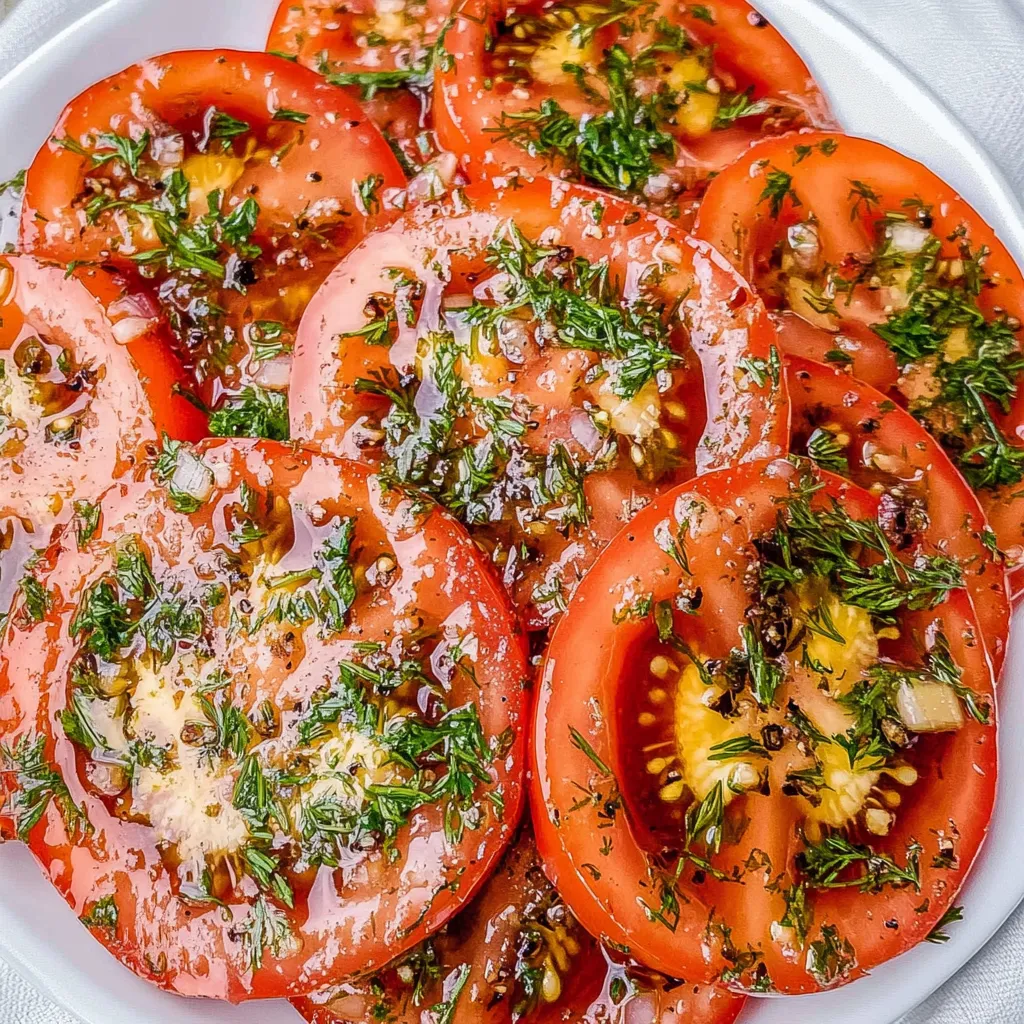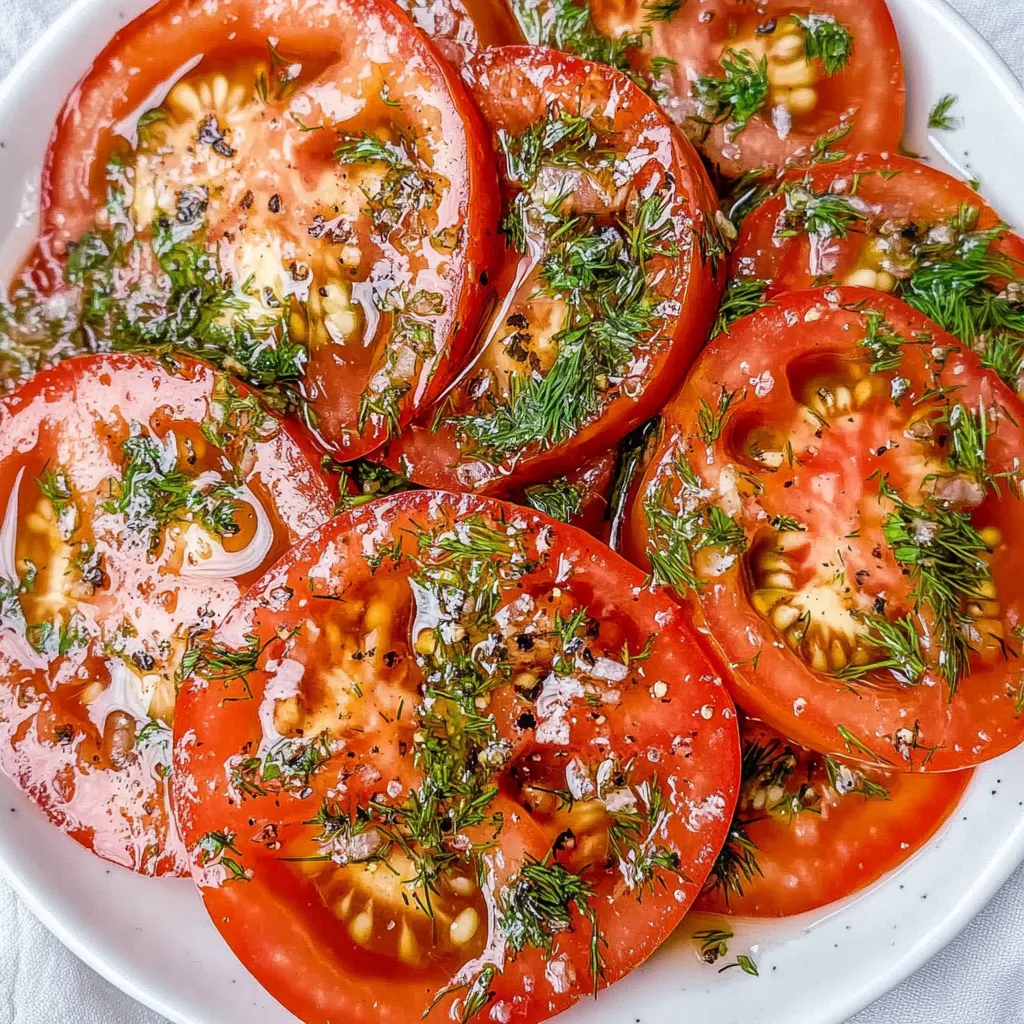 Pin it
Pin it
This hearty marinated tomato dish has been my summer staple for years—perfect when garden tomatoes are at their peak. The combination of fresh herbs, garlic, and tangy balsamic creates a simple yet impressive side that elevates any meal.
I first made these marinated tomatoes for an impromptu backyard gathering, and they disappeared faster than anything else on the table. Now they're requested at every summer potluck and family barbecue.
Ingredients
- Four large ripe tomatoes: Select firm ones that still have some give when gently pressed
- Two garlic cloves: Freshly pressed garlic provides the best flavor punch
- One quarter small white onion: Adds a pleasant bite that mellows during marination
- Half bunch fresh dill: The feathery herb adds brightness but can be substituted
- Quarter cup extra virgin olive oil: Use your best quality oil as it carries the flavors
- Two tablespoons balsamic vinegar: Provides sweetness and acidity for balance
- One tablespoon honey: Enhances the natural sweetness of the tomatoes
- Kosher salt and ground black pepper: Essential for bringing all flavors together
Step-by-Step Instructions
- Prepare the tomatoes:
- Slice your tomatoes into approximately 1/3-inch thick rounds. The thickness matters here—too thin and they'll fall apart, too thick and they won't absorb the marinade properly. Arrange them on a shallow platter where they can slightly overlap but mostly lie flat.
- Create the marinade:
- Finely chop the garlic and onion to ensure they distribute evenly through the marinade. Mince your herbs of choice until they release their aromatic oils. In a small bowl, combine these aromatics with the olive oil, balsamic vinegar, and honey. Whisk thoroughly until the honey is fully incorporated.
- Season and assemble:
- Generously sprinkle salt and freshly ground black pepper over the arranged tomato slices. The salt not only seasons but helps draw moisture from the tomatoes, allowing them to better absorb the flavors. Carefully spoon the marinade over each tomato slice, ensuring even coverage.
- Marinate properly:
- Cover the platter with cling film, pressing it gently against the surface to prevent air exposure. Refrigerate for at least one hour, though three to four hours will develop even deeper flavors. The waiting is the hardest part but absolutely necessary for flavor development.
 Pin it
Pin it
The balsamic vinegar is my secret weapon in this recipe. When I first started making these marinated tomatoes, I used only olive oil and herbs, but adding that touch of aged balsamic transformed the dish completely. My grandmother tasted them and immediately demanded the recipe—high praise from someone who rarely used written recipes!
Serving Suggestions
These marinated tomatoes shine brightest when paired with crusty bread that can soak up the flavorful juices. I often serve them alongside grilled proteins like chicken or fish for a light summer meal.
 Pin it
Pin it
Seasonal Variations
In summer when tomatoes reach their peak sweetness, I use heirloom varieties in different colors for a stunning visual presentation. The varying sweetness levels between yellow, green, and deep red tomatoes create a more complex flavor profile.
Storage Tips
These marinated tomatoes will keep beautifully in the refrigerator for up to three days. The flavors actually improve after the first day as the tomatoes continue to absorb the marinade.
Frequently Asked Questions
- → Can I substitute the dill with another herb?
Yes, fresh basil, parsley, or cilantro are great alternatives to dill. Use whichever herb you prefer.
- → What type of tomatoes should I use?
Choose ripe but firm tomatoes. Avoid using overly soft or mushy tomatoes for the best texture.
- → How long should I marinate the tomatoes?
Refrigerate the marinated tomatoes for at least 1 hour for optimal flavor infusion.
- → Can I use a different oil instead of olive oil?
Yes, avocado oil works well as a substitute for olive oil in this dish.
- → Is balsamic vinegar necessary for the recipe?
Balsamic vinegar adds depth and sweetness to the marinade, but you can use red wine vinegar or apple cider vinegar as an alternative.
